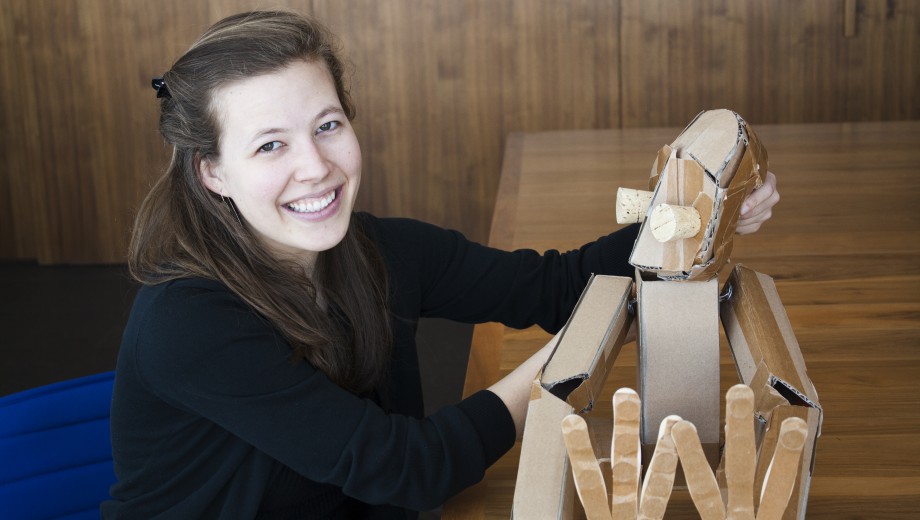In “Power Play,” Tableau spoke with Marissa Fenley about her research on puppets as performance and literary metaphor, particularly her work on ventriloquism. Here she talks more about other types of puppetry and her own practice in creating and operating puppets.
What do you call yourself?
I was calling other people in my field “puppet scholars,” and one of my advisers said that sounds like a puppet who is a scholar. I do see myself as a performance scholar.
Have you always been interested in puppets?
I’ve been making puppets since I was very little. I grew up in a family of artists who are into found-object art. When you find trash, essentially, you turn it into something fun. You make a puppet and then you play with it. Anyone can do puppetry—it’s very easy to make an object seem alive. I’m not a ventriloquist—that’s really hard—but the basics of animating something have a low entry point.
Putting stuff on popsicle sticks is puppetry.
Exactly. Perfecting advanced techniques takes years and years, but like 75 percent of the work is done by just picking up the object and treating it like it’s alive.
Have you done any formal training?
I did a workshop with an amateur puppet troupe in Chicago called Rough House; they’re really into democratizing puppetry. I also took a shadow puppetry class in TAPS [the Committee on Theater and Performance Studies], which was really challenging.
Do you put on shows?
I’ve been working with an English Language and Literature department colleague, Bill Hutchison, AM’12, AM’15, PhD’20, who works with robots. Last year we put on an event called Experiments in Critical Silliness, which investigated silliness as a method for approaching serious questions. We reenacted famous romantic scenes—from Casablanca, Titanic, When Harry Met Sally—using a hand puppet and a robot. The puppet was more expressive than the robot, and we found that the scenes worked best when the robot was the woman, because in most of these scenes, she does nothing. The man expresses passion at her vociferously, except for When Harry Met Sally, the fake orgasm scene, which reversed those terms profoundly. The event was going to happen again this year but got canceled due to COVID-19.
Your next dissertation chapter is on protest puppetry. What’s an example?
The aesthetics of protest puppetry were defined by a radical collective called Bread and Puppet. They’ve been around since the ’60s and make these huge papier-mâché puppets, which are light and easy to carry and can be made without professional expertise, making it a democratic art-making process.
There was an ecofeminist collective called the Women’s Pentagon Action in the 1980s, and for one of their events, they carried four puppets made by Bread and Puppet, each representing a different emotion expressing antiwar sentiment. They wove string around the entire Pentagon, halting anyone from entering, and the puppets became the face of what they stood for. There’s a political puppet company called In the Heart of the Beast in Minneapolis. I would have loved to visit while working on the next chapter, but it’s closed.
What else are you missing because of the pandemic?
I was supposed to be in Japan right now doing an internship with a puppet company. And an international puppet festival in Chicago that happens every other year that has been canceled.
How does puppetry differ country to country?
Puppetry is an incredibly old art form, but folk traditions emerged in different places. Punch and Judy would be the primary European one. American puppetry came from Europe. There was a renaissance in the 1920s in the avant-garde theater when European experimenters went to Asia and borrowed from Japanese folk puppetry, mostly Bunraku, and Indonesian shadow puppetry and turned it into high art.
Are Muppets their own animal?
Yes, but I haven’t done as much research on them yet. The Jim Henson Company is very closed-door; they don’t want people knowing about their internal operations. There’s a Muppet archive, but it was hard for me to find, and once I did, I discovered that it costs $200 a day with a limit of five days. There’s one Muppet archivist, so the Muppet narrative is contained and controlled.
That’s very antithetical to the Jim Henson mythos.
Maybe because Disney bought the Muppets in 2004. But yes, the advent of plush puppets was Jim Henson’s innovation. Hand puppets were mostly glove puppets with cloth and a hard head, like Punch and Judy.
Like the puppets on Mister Rogers’ Neighborhood. They used to scare me.
My sense is that the change had a lot to do with televising puppets, because they realized that wooden puppets don’t read well on TV. Shari Lewis started with a wooden dummy, and they told her she needed something less stiff. That’s when sock-based Lamb Chop appeared. Jim Henson took the sock puppet and turned it into a massive commercial industry.
Do you find puppets creepy?
I’ll have to articulate the uncanny at some point, but that’s not really an important category for me, which is weird for a puppet person. I think that’s how most people explain their discomfort, though: they’re too close to dead things. I think they’re more like dead ideas about what people are; they’re not what animates us, and yet they are very much animating these things for us.

